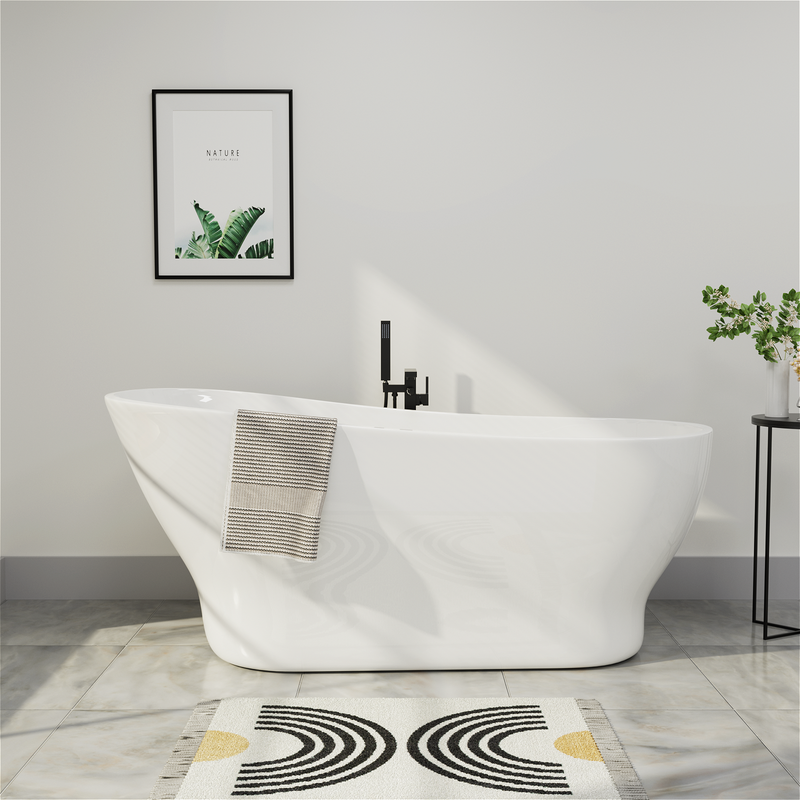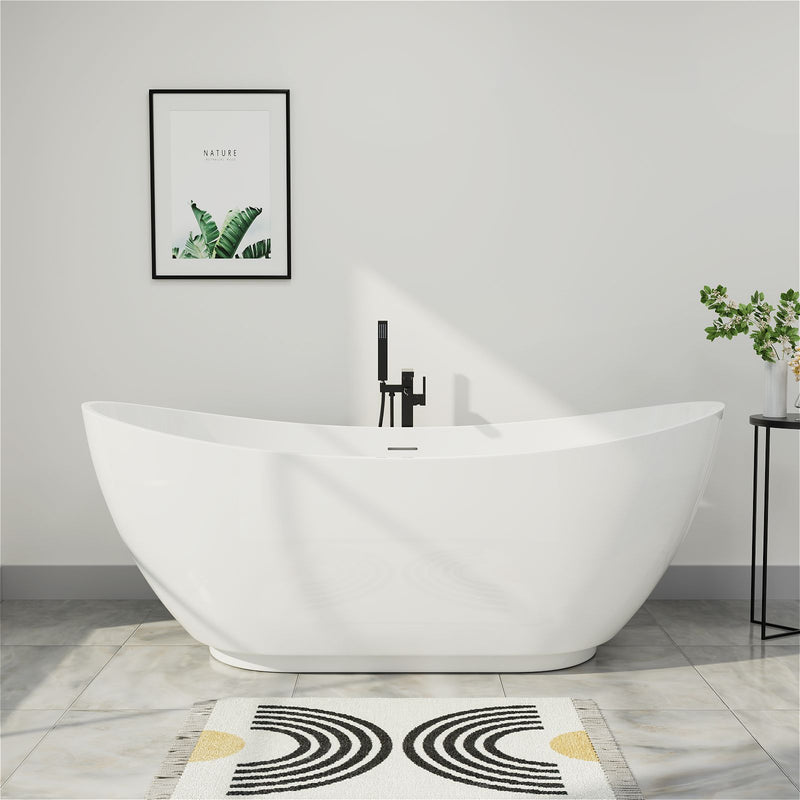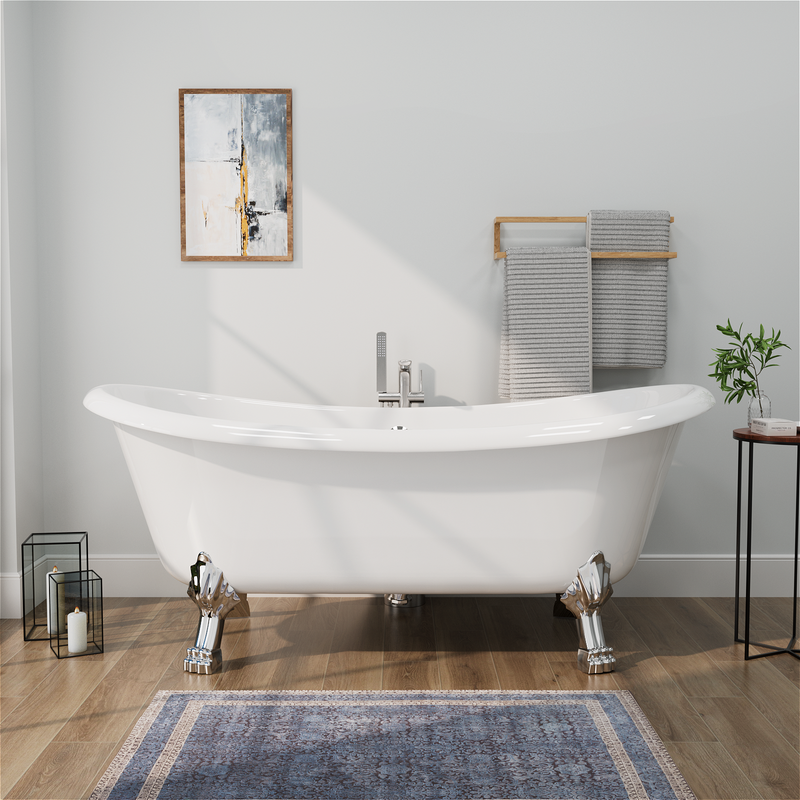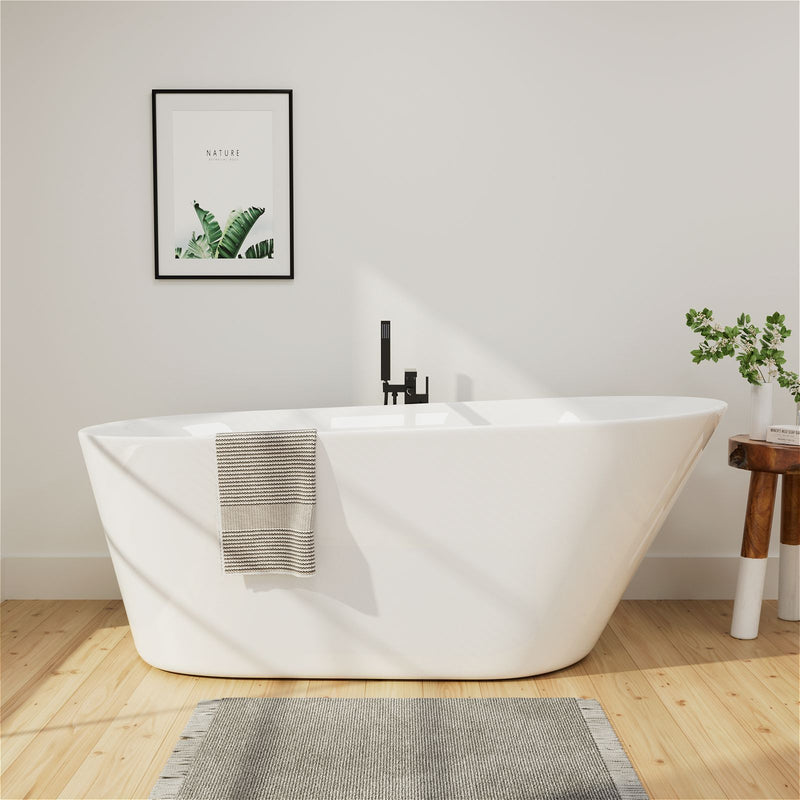When a sleek bathtub perfectly complements gleaming wall tiles, people often marvel at the overall aesthetic of the bathroom space. However, the crucial line of defense that supports both beauty and functionality often lies hidden in that inconspicuous joint - the bathtub caulking. This thin "sealing strip" silently withstands the impact of water, temperature fluctuations, corrosion from cleaning agents, and the invasion of mold. Choosing the wrong material or improper application can, at best, cause the caulking to become black and moldy, unsightly, or, at worst, lead to water seepage and leakage, eroding the wall structure, and causing costly repairs.
Silicone, epoxy, and acrylic - the three mainstream caulking materials - each have distinct characteristics and applications. The differences between them go far beyond price. This article will delve into the core performance, application characteristics, durability, and applicable environments of these three materials, providing a clear and practical selection guide to help you protect every inch of your bathtub perimeter and create a durable, clean bathroom space.
Performance Comparison: Waterproofing, Moldproofing, and Durability
The core mission of caulking materials is sealing and protecting. Waterproofing, mold and antibacterial properties, and long-term durability are the primary criteria for evaluating their quality.
Waterproofing and Sealing: Which is the True "Watertight Guardian"?
Silicone (Silicone Sealant)
- Superior Elasticity: Silicone has extremely high elastic deformation capacity (elongation can reach over 200%-400%). When the bathtub undergoes slight changes due to load, temperature fluctuations, or building settlement, silicone expands and contracts accordingly, maintaining a constant seal and effectively preventing moisture from seeping through gaps in the wall or floor.
- Perfect Fit: Its soft texture allows it to perfectly conform to irregular gaps between the bathtub rim and the tiles, forming a continuous, seamless seal.
- Conclusion: It offers the best waterproof sealing performance, especially suitable for bathtub enclosures that must accommodate movement and deformation.
Epoxy Resin Caulk
- Rigid Sealing: After curing, it forms an extremely hard, dense surface that is virtually impermeable to water and air. Its body is extremely waterproof.
- Flexibility Weakness: Rigidity is both its strength and its fatal weakness. It has virtually no elasticity. Even the slightest movement of the bathtub or base (common in bathroom environments) can cause the rigid epoxy seams to crack. Once cracked, the waterproof barrier loses its effectiveness and cannot heal itself.
- Conclusion: While the body is extremely waterproof, its lack of elasticity makes it less reliable in dynamic environments (such as around bathtubs), making it susceptible to cracking and leakage.
Acrylic Caulk (Including Latex Acrylic)
- Moderate Waterproofing: It offers a certain degree of hydrophobicity and resistance to water penetration, making it resistant to daily splashes and brief periods of humidity.
- Porosity: The cured structure is relatively porous (especially in low-end products). Under prolonged immersion or water pressure, moisture can slowly penetrate into the seams and even the base.
- Conclusion: Suitable for dry or slightly humid areas. Its waterproofing performance is insufficient around bathtubs, where it is exposed to heavy, prolonged water exposure, making it a poor choice.
Anti-mold and Antibacterial Properties
Silicone (Silicone Sealant)
- Inherent Weaknesses: Silicone itself contains no nutrients, but its surface microstructure easily absorbs organic matter such as dust and soap scum from the air, creating a breeding ground for mold spores. Ordinary silicone is the most susceptible to mold and blackening of the three.
- Improved Options: "Anti-mold silicone" with high-efficiency anti-mold agents is available on the market. These can significantly inhibit mold growth and extend cleaning time, but they don't provide lifelong immunity, and their effectiveness diminishes over time. Choosing high-quality anti-mold silicone is key.
Epoxy Resin Caulk
- Mold-Resistant Champion: After curing, it forms an extremely smooth, dense, porcelain-like surface, leaving virtually no room for mold to attach and grow. Its inert nature makes it difficult for microorganisms to decompose and utilize it.
- Easy to Clean: The smooth surface resists soap scum and water stains, making daily cleaning easy and quick.
- Conclusion: Optimal anti-mold and anti-bacterial properties, ensuring the best long-term cleanliness.
Acrylic Caulk
- Porous and Dirt-Absorbent: The relatively rough and porous surface easily attracts soap scum, sebum, dust, and other contaminants.
- Mold Breeding: The porous structure and adsorbed organic matter make it an ideal habitat for mold growth, resulting in rapid and widespread mold and blackening.
- Conclusion: The poorest mold resistance, with a high risk of mold around damp bathtubs.
Durability and Aging Resistance
Silicone (Silicone Sealant)
- Weather Resistance: Highly resistant to UV rays and temperature fluctuations (-50°C to 200°C+), resisting hardening, brittleness, or cracking.
- Long-Term Elasticity: High-quality silicone can maintain good elasticity for up to 10-20 years in indoor bathroom environments. The main signs of aging are yellowing (related to additives) and a decrease in mold resistance.
- Conclusion: Excellent long-term durability, especially long-lasting elasticity.
Epoxy Resin Caulk
- Extreme Hardness and Wear Resistance: After curing, it exhibits exceptional hardness, excellent resistance to wear, scratches, and impact, and is virtually impervious to physical damage.
- Chemical Inertness: Resistant to acids, alkalis, solvents, and most cleaning agents, it possesses excellent chemical stability.
- Brittleness and Yellowing: Its primary weakness is brittleness, making it susceptible to substrate displacement and impact. Some epoxies may experience slight yellowing under prolonged sunlight exposure (though this has minimal impact on functionality).
- Conclusion: It offers top-tier physical and chemical durability, but brittleness is its Achilles' heel. It has an extremely long lifespan on stable substrates.
Acrylic Caulk
- Susceptible to Aging and Cracking: It exhibits poor weather resistance and is susceptible to hardening, shrinking, cracking, and powdering after prolonged exposure to humidity, wet-dry cycles, or temperature fluctuations.
- Abrasion Resistance: The surface is relatively soft and easily scratched by hard objects.
- Conclusion: It has the weakest durability of the three caulk types, especially in humid, frequently used bathtub environments, where its lifespan is limited (perhaps only a few years).
Application Experience and Maintenance: DIY-Friendliness vs. Daily Care
The ease of application and subsequent maintenance directly impact the user experience and long-term results.
Application Difficulty: Which is Easier?
Silicone Sealant
- High Tool Requirements: Application relies heavily on skill and tools (a high-quality caulking gun, caulking tools, and masking tape). Extrusion force, movement speed, and caulking technique directly impact aesthetics.
- Difficult to Rectify: Misapplication or staining on unwanted areas (such as bathtub glaze or tile surfaces) can be extremely difficult to clean while wet; after curing, it's virtually impossible to remove without damage.
- Curing Conditions: Curing relies on moisture from the air, requiring a certain humidity level. Curing time is relatively long (several hours for surface crusting and 24-72 hours for full cure).
- Conclusion: Application is the most challenging, and novice DIYers are prone to failure (e.g., unevenness, bubbles, and rough edges). It is strongly recommended to consult experienced professionals or a professional.
Epoxy Resin Caulk
- Strict Mixing Requirements: Most are two-component (resin A + curing agent B), requiring a strict, thorough mixing ratio. Otherwise, curing will fail or performance will deteriorate. The working time after mixing is short (typically 30-90 minutes).
- Quick and Precise Application: The mixed material is highly viscous, requiring quick and precise filling and smoothing of gaps. High application speed is crucial.
- Difficult to Clean: Uncured, it is highly viscous, making it extremely difficult to clean after contamination. Once cured, it is extremely hard and challenging to remove.
- Conclusion: Application is the most challenging, with a short working window, making it extremely difficult for beginners and requiring professional application.
Acrylic Caulk
- Simple Application: Most are single-component pastes (similar to toothpaste) and ready to use right out of the can. Application can be applied directly with a spatula or your gloved fingers, making it easy and intuitive.
- Easy to Correct: While still wet, excess can be easily wiped off and reshaped with a damp cloth or sponge. Curing and Drying: Curing primarily relies on water evaporation, resulting in a relatively fast cure (surface drying takes tens of minutes to several hours, and full cure takes 1-7 days).
- Conclusion: The easiest and fastest application method, with a high tolerance for error, makes it the top choice for DIY users.
Daily Cleaning and Maintenance: Which is the Least Stressful?
Silicone (Silicone Sealant)
- Easy to Clean: The cured surface is smooth, allowing for easy removal of water stains and soap scum with a damp cloth.
- Mold Prevention Considerations: Ordinary silicone sealant requires regular use of a mold inhibitor or specialized cleaner to inhibit mold growth. Once mold forms, it is difficult to completely remove, often requiring scraping and reapplying.
- Conclusion: Easy to clean, but proactive mold prevention maintenance is required.
Epoxy Resin Caulk
- Easiest to Clean: The extremely smooth and dense surface makes it virtually impervious to dirt, soap scum, and water stains. Wipe with a damp cloth for a bright, new look.
- Almost Maintenance-Free: Its excellent stain and mold resistance means minimal maintenance is required.
- Conclusion: Daily cleaning and maintenance are the easiest and most labor-saving, practically maintenance-free.
Acrylic Caulk
- Stain-Sensitive: The porous surface easily absorbs stains and soap scum, resulting in difficult-to-remove stains.
- Mold-Prone: Mold easily grows, and mold easily penetrates the interior, making it difficult to eradicate with conventional cleaning, often making it dirtier with each scrubbing.
- Conclusion: The most difficult to clean and maintain, requiring frequent scrubbing with ineffective results.
Repair and Replacement
Silicone (Silicone Sealant)
- Replacement is Relatively Feasible: After aging or mold, the old sealant can be carefully removed with a utility knife (taking care to avoid damaging the bathtub glaze and tiles). After cleaning the substrate, new sealant can be reapplied.
- Conclusion: Repair and replacement are possible, but require skill.
Epoxy Caulk
- Extremely Difficult to Remove: After curing, it is extremely hard and strongly bonds to the substrate, making complete removal extremely difficult (requiring power tools for sanding and cutting), and can easily damage the bathtub or tiles.
- Conclusion: Virtually irreversible, replacement is costly and risky.
Acrylic Caulk
- Easy to Remove: It often becomes brittle, chalky, or cracked after aging, making it relatively easy to remove with tools.
- Conclusion: Replacement is the easiest.
Application Scenarios and Ultimate Selection
There's no perfect material; there's only the best option for a specific situation.
Recommended Core Applications
Silicone (Silicone Sealant)
- Best Suitable for: The joints between all bathtub types (freestanding, built-in, acrylic, cast iron, artificial stone) and walls/floors. It's especially important for the gap where the bathtub's base meets the floor (where movement is greatest).
- Key Advantage: Its excellent elastic sealing ability is key to accommodating the inevitable micro-movements that occur during bathtub use and ensuring long-term waterproofing.
- Choice Key: Be sure to choose a high-quality, neutral-curing silicone sealant with a highly effective mildew-resistant agent (such as "kitchen and bathroom mildew-resistant"). Avoid using inferior acidic sealants (which are highly corrosive and prone to mold growth).
Epoxy Resin Caulk
- Best Suited for: Wall and floor joints between tiles (especially shower floors and wet area walls). Or the joints between bathtub countertops and wall tiles (if the area is very stable and the risk of movement is minimal).
- Caution Around Bathtubs: It is strongly not recommended for use in primary sealing joints between the bathtub body and any substrate (wall or floor). Its brittleness cannot withstand the movement of the bathtub and is prone to cracking and leaking.
- Key Advantages: Superior hardness, wear resistance, extreme mildew resistance, and easy cleaning. Suitable for stable, intensive use, and areas requiring the utmost cleanliness.
Acrylic Caulk
- Best Suited for: Cracks between tiles in dry or semi-dry areas, such as bathroom walls, kitchen walls (not around stoves and sinks), and living room floors.
- Absolutely Avoid: Strictly avoid use around bathtubs, showers, basins, and any other areas subject to long-term, direct water contact or high humidity. Its waterproof and mildew resistance may not meet your requirements.
- Key Advantages: Affordable price, extremely simple and quick installation (DIY-friendly), and a wide variety of colors. This is a good option for a limited budget, dry area, and short-term solution.
Which Should You Choose for Your Bathtub Caulking?
Grout Location
- The joint between the bathtub rim and the wall/floor (a critical waterproofing joint): Choose high-quality, mildew-resistant silicone.
- For the joint between the bathtub countertop (not the bathtub itself) and the wall, and if the structure is confirmed to be extremely stable: Consider epoxy resin (but silicone is still a safer option).
- For tile joints on walls/floors in other dry areas of the bathroom: Consider acrylic (for low budgets/DIY) or epoxy resin (for ultimate durability and cleanliness).
Budget and DIY Skills
- For those seeking optimal waterproofing and anti-movement performance, who are willing to accept professional work or are willing to learn delicate techniques: choose mildew-resistant silicone.
- For those with a sufficient budget, who seek extremely durable and easy-to-clean tile joints (not the bathtub grout), and who have professional work: choose epoxy resin (for brick joints).
- For those with a very low budget, an absolutely dry area, and who are DIYing and have simple requirements: choose acrylic (for dry areas only).
Cleanliness (and Mildew Prevention) Requirements
Extremely Demanding, Averse to Black Grout: Epoxy resin (for brick joints) > High-quality mildew-resistant silicone > Acrylic. Able to tolerate regular maintenance and mildew prevention: High-quality mildew-resistant silicone.
Conclusion
The thin caulking around the bathtub is a silent guardian against flooding and safeguarding your bathroom's health. Choosing silicone, epoxy, or acrylic is no haphazard decision. It's a precise one based on scientific performance and application scenarios.
- Silicone, with its unparalleled elasticity and sealing properties, is the unmatched choice for waterproofing and leak-proofing around the bathtub itself. Investing in high-quality mildew-resistant silicone and mastering (or hiring) professional installation techniques are essential to ensuring this line of defense remains sturdy and reliable for decades.
- Epoxy, with its indestructible strength and spotless surface, shines in tile grouting, where extreme cleanliness and wear resistance are crucial. However, remember that its fragile nature cannot withstand the pulsation of a bathtub; avoid using it for critical dynamic seals.
- Acrylic's low barrier to entry and ease of application make it an economical choice for caulking in dry areas. However, its fragility is inherently vulnerable to the evaporation of water around the bathtub, and forcing it to function will only lead to endless mold and mildew problems.
Understand the essence of the material and respect the purpose of gaps. Choose the perfect protector for your bathtub, ensuring every enjoyable bath is built on a solid, clean foundation. This meticulous attention to detail is the wisdom behind creating a timeless, healthy, and comfortable bathroom space.





